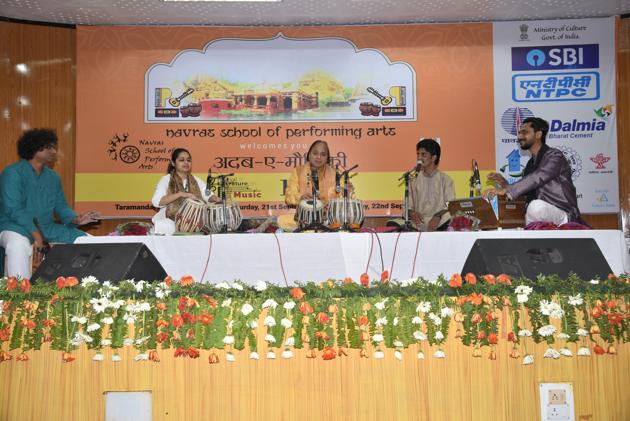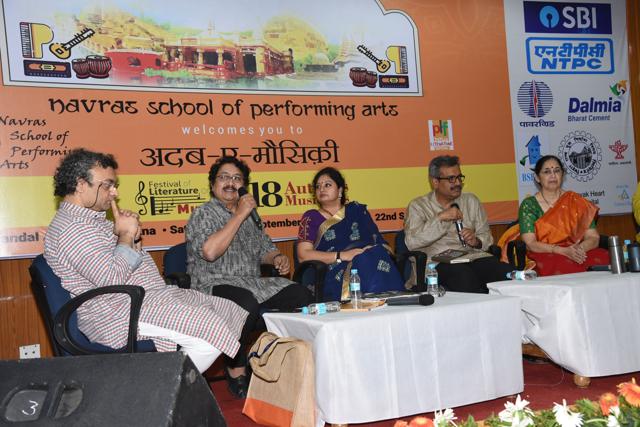A festival of literature on music: At Adab-e-Mausiqui in Patna
“The idea of a festival of literature on music came to my mind some eight years ago when the late Gana-Saraswati Kishori Amonkar made me realise the importance of murchhana in Hindustani music explaining it through raga Lalit. ‘Lalit is a madhyam pradhan raga’, a raga with a prominent madhyam, if you take madhyam or ‘Ma’ as the tonic, it would sound like todi’.
“The idea of a festival of literature on music came to my mind some eight years ago when the late Gana-Saraswati Kishori Amonkar made me realise the importance of murchhana in Hindustani music explaining it through raga Lalit. ‘Lalit is a madhyam pradhan raga’, a raga with a prominent madhyam, if you take madhyam or ‘Ma’ as the tonic, it would sound like todi’.’ It was then that I realized the significance of literature on music” said Ajit Pradhan, the cardiologist and surgeon from Patna, who established the Navrasa School of Performing Arts to revive Bihar’s tradition of classical music, dance, and literature.

Pradhan was speaking at the inaugural session of Abab-e- Mausiqui, a festival of literature on music, presented by the Navras School at the Taramandal Auditorium in Patna on September 21 and 22. The festival was an endeavour to bring together musicians, thinkers and authors related to music on a single platform to rekindle the interest in reading books and essays on Indian classical music. Various traditions of performing arts of India were discussed along with vocal and instrumental concerts, talks and panel discussions. Interesting anecdotes about the lives of musicians, gharanas, tawaifs and devadasi traditions were shared. Navras intends to honour a musician or an author writing on music during this annual event starting this year with Vidushi Padma Talwalkar, the exponent and guru from the Jaipur Atrauli Gharana, for her contribution to Hindustani classical music.

The first session moderated by Shinjini Kumar focussed on ‘Music & the Maestros’, with Yatindra Mishra, Vikram Sampat and Namita Devidayal as panelists. Shalini introduced the subject reciting Shuddh Kalyan, a poem written by the Hindi poet Mangalesh Dabral inspired by a rendering of the reflective raga by Bhimsen Joshi. Namita Devidayal talking about her book The Music Room, said, “Writing about my close connection with my guru Dhondhutai Kulkarni was also the story of ‘Guru Shishya Parampara’ in Indian music.” Vikram Sampat and Yatindra Mishra talked about their own experiences while writing books on music maestros. Akhilesh Jha shared his experiences while writing a book on Mehdi Hasan.
During a session on the gharana tradition with panelists Irfan Zuberi, Meeta Pandit and Ajit Pradhan, Vidushi Padma Talwalkar talked about her training under her gurus. On Mogubai Kurdikar she said: “It took the longest time in training with her for a perfect aakar because the Jaipur Gharana emphasises on seedha sur without any ornamentation, while rendering a bandish (composition).” Gajananbua Joshi, her other guru, made her realise what she wanted in her music. This led Talwalkar to understand that her music should not be a patchwork of Gwalior, Jaipur and Kirana but the composite essence of all three.
Meeta Pandit talked about her training in Gwalior Gayaki, specifically in Pandit Parampara, her own family tradition, and demonstrated the speciality of her Gharana by singing the mukhda of a tap-tarana, which was a combination of tappa and tarana and an ashtapadi of Jayadeva composed in raga Bhupali. Dr Pradhan added: “Kirana is Swar-Pradhan, Agra is Laya-Pradhan and the other Gharanas come in-between.”
Aneesh Pradhan, the tabla exponent and writer on music differentiated between biradari, khandan and gharana. Biradari, he explained, was the general music fraternity; khandan referred to hereditary musicians, while the gharana underlines the aesthetic identity of a family of musicians or the Guru-shishya parampara. “Gharana to me is not just the hereditary lineage but a vichar-dhara, a stream of thoughts with a certain conviction, which works as the foundation,” he said before speaking about the different gharanas or baaj (styles) of tabla playing according to the tonal quality of the instrument and ornamentations.
The session Nazaqat, Riwayat, Ada focused on thumri ghazal and the tawaif tradition with Vidya Shah and Arun Singh while the session ‘Devapriya and Devdasi; from Eternal to Classical’ had Pavan Verma and Swarnamalya Ganesh. Swarnamalya spoke with conviction before demonstrating abhinaya from the devdasi or sadir tradition. The session on Riwayati Purab Ang Gayaki moderated by Irfan, had Vidya Rao speaking about it while Sayara Begum melodiously demonstrated compositions like Humse na bolo Raja and Kankar mohe laag jaihen na re… compositions of thumri and dadra styles, in her seasoned voice, and mesmerised the audience.

The performances had Meeta Pandit singing Vilambit and Drut Khayals in raga Puriya Dhanashri, Thumri Khamaj and a Kajri. The ‘Dhrupad Ki Dharohar’ session the following morning opened with an impressive dhrupad recital by Prashant and Nishant Mallick, representatives of the Darbhanga Gharana, who performed aalap and dhrupad in raga Parmeshwari in chautal and a Kabir pada in sul-tala.
The festival reached its climax with ‘Avartan’, the poetic interpretation of laya-tala by Suresh Talwalkar assisted by Sawani Talwalkar on tabla, Umesh Warbhuvan on cajon and vocal accompaniment by Nagesh Adgaonkar and harmonium by Tanmay Deochake, playing a variety of Chhand in Misra, Chatusra, Khanda and Misra Jati in Peshakara itself, to a composition of Chhota Gandharrva set to drut ek-tala. They concluded with a composition of Mogubai in raga Sohani set to the challenging time cycle of 14 beats of Ada-Chautala, which got a standing ovation.
The festival will also be remembered for the artistic decor of the venue.
Manjari Sinha is an independent journalist who writes on classical music and dance






